Recent Fire Damage Posts
Restoring Your Home After Fire Damage: How SERVPRO Makes It Look "Like it Never Even Happened
7/22/2024 (Permalink)
 Reduce your Risk in North Central Colorado Spring, CO
Reduce your Risk in North Central Colorado Spring, CO
Fire damage can be one of the most devastating events a property owner can experience. Beyond the immediate destruction caused by the flames, there are often extensive issues related to smoke damage, water damage from firefighting efforts, and structural compromises. At SERVPRO®, we understand the emotional and physical toll this can take on homeowners. Our comprehensive fire damage restoration process is designed to not only restore your property but to also give you peace of mind, making it seem "like it never even happened.
Initial Contact and Assessment
The restoration process begins the moment you contact us. Our 24/7 emergency response ensures that we can start the assessment and mitigation process as quickly as possible, minimizing further damage. When our team arrives on-site, we conduct a thorough inspection to assess the extent of the fire, smoke, and soot damage. This assessment includes checking for structural integrity, identifying affected areas, and determining the best course of action for restoration.
Securing the Property
Before any restoration work begins, it's crucial to secure the property to prevent further damage and ensure safety. This step often involves boarding up windows and doors and placing tarps on damaged roofs. By securing the property, we protect it from weather elements, vandalism, and additional structural collapse, allowing our team to work safely and efficiently.
Water Removal and Drying
Firefighting efforts often leave behind significant water damage. The next step in the restoration process involves the removal of standing water and thorough drying of affected areas. Our technicians use powerful pumps and industrial-strength dehumidifiers to extract water and dry out the structure. This step is vital to prevent mold growth and further deterioration of materials.
Soot and Smoke Removal
One of the most challenging aspects of fire damage restoration is dealing with soot and smoke residues. These residues can penetrate surfaces and leave behind persistent odors and discoloration. Our team employs specialized equipment and techniques to remove soot from walls, ceilings, and other surfaces. We use air scrubbers, thermal foggers, and ozone generators to eliminate smoke odors, ensuring that your home smells fresh and clean.
Cleaning and Sanitizing
Once the soot and smoke residues are removed, we focus on cleaning and sanitizing the affected areas. This step involves using advanced cleaning products and techniques to clean and sanitize all restorable items and structures. We pay special attention to personal belongings, furniture, and other valuable items, ensuring they are thoroughly cleaned and deodorized. Our goal is to restore your possessions to their pre-fire condition whenever possible.
Restoration and Repairs
The final step in the fire damage restoration process is the actual restoration and repairs. This phase can range from minor repairs, such as replacing drywall and painting, to major reconstruction efforts. SERVPRO has a team of skilled contractors who can handle all aspects of the restoration, ensuring a seamless and efficient process. Our comprehensive approach means you won't need to hire multiple contractors, saving you time and reducing stress.
Specialized Services
In addition to the standard fire damage restoration steps, SERVPRO offers specialized services to address unique challenges. These services include:
Document and Media Recovery: We use state-of-the-art techniques to restore important documents, photographs, and media that may have been damaged in the fire.
Electronics Restoration: Our technicians can evaluate and restore electronic devices affected by fire and smoke damage, helping you salvage valuable equipment.
Art and Antiques Restoration: We work with specialized conservators to restore valuable artworks and antiques to their original condition.
Customer Communication and Support
Throughout the entire restoration process, we prioritize clear and consistent communication with our customers. We understand that fire damage can be overwhelming, and we aim to provide reassurance and support every step of the way. Our team keeps you informed about the progress of the restoration, addresses any concerns, and works closely with your insurance company to facilitate a smooth claims process.
The SERVPRO Difference
What sets SERVPRO apart is our commitment to excellence and customer satisfaction. Our highly trained technicians are certified by the Institute of Inspection Cleaning and Restoration Certification (IICRC) and receive ongoing training to stay up-to-date with the latest industry standards and techniques. We use advanced equipment and technology to ensure the highest quality of service.
Our "Like it never even happened" promise reflects our dedication to restoring your home to its pre-fire condition. We understand the importance of getting your life back to normal as quickly as possible, and we strive to exceed your expectations in every aspect of the restoration process.
Preventive Measures and Education
At SERVPRO, we believe that prevention is key to reducing the risk of fire damage. We offer educational resources and services to help homeowners implement fire safety measures and reduce the likelihood of future incidents. From installing smoke detectors to creating fire escape plans, we provide valuable information to keep your family and property safe.
Experiencing a fire in your home is undoubtedly a traumatic event, but with SERVPRO by your side, you can rest assured that your property is in capable hands. Our comprehensive fire damage restoration process is designed to address every aspect of the damage, from initial assessment to final repairs. With our expertise, advanced technology, and commitment to customer satisfaction, we make it our mission to restore your home to its former glory, making it truly "Like it never even happened." If you ever find yourself in need of fire damage restoration services, don't hesitate to contact us. We're here to help you every step of the way.
The Comprehensive Guide to Fire Damage Restoration in Colorado Springs, CO
10/19/2023 (Permalink)
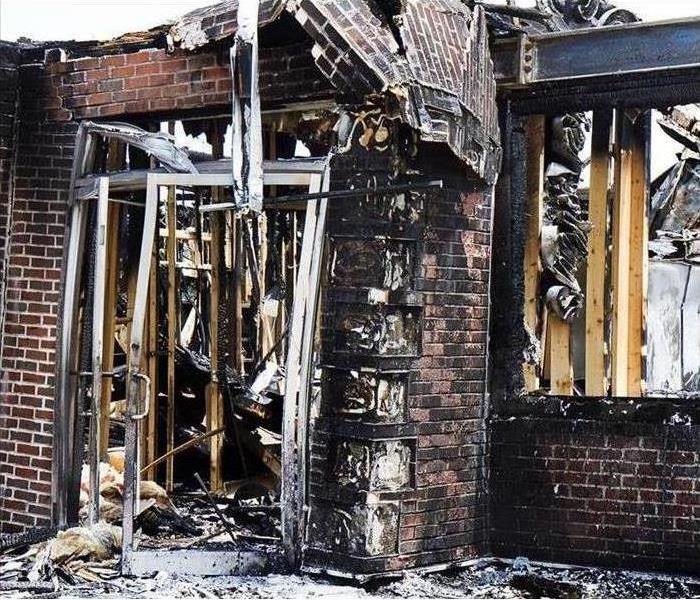 Fire damaged home in Colorado Springs, CO.
Fire damaged home in Colorado Springs, CO.
Facing a fire in your home is a devastating and overwhelming experience. Beyond the immediate danger of the flames, the aftermath often leaves homeowners grappling with the emotional and logistical challenges of recovery. Fire damage can range from charred walls and smoke-stained ceilings to water damage from firefighting efforts. The process of restoring your home can seem daunting, but there is hope. In this comprehensive guide, we will take an in-depth look at the 4-step fire restoration process that SERVPRO of North Central Colorado Springs follows to help homeowners rebuild and reclaim their lives after suffering fire damage.
The 4-Step Fire Restoration Process
Step 1: Assessment and Inspection
The first step in the fire restoration process is the assessment and inspection of the damaged property. This initial phase is critical as it sets the foundation for the entire restoration plan. SERVPRO of North Central Colorado Springs deploys experienced professionals who meticulously examine every aspect of your home affected by the fire.
Damage Evaluation: The assessment begins with a detailed evaluation of the extent of damage. This includes the visible signs of fire and smoke damage but also extends to less apparent issues like structural damage, compromised electrical and plumbing systems, and potential health hazards.
Salvageable Items: During the assessment, the team identifies items and materials that can be salvaged. This can include valuable personal belongings, furniture, and sentimental items. A comprehensive inventory is created to guide the restoration process.
Restoration Plan: The assessment phase results in a detailed restoration plan tailored to the specific needs of your property. Each plan is unique, addressing the individual characteristics of your home and the extent of the damage.
Insurance Coordination: We work closely with your insurance company to ensure that you receive fair coverage. This collaborative approach is designed to streamline the claims process, and it aims to guarantee that no damage is overlooked.
Step 2: Mitigation and Securement
Once the assessment is complete, the next critical step is mitigating further damage and securing the property. This is essential to prevent additional harm and ensure the safety of your home.
Securing the Property: After a fire, your home may be exposed to the elements, vandalism, or theft. SERVPRO of North Central Colorado Springs takes immediate action to secure your property. This includes boarding up windows, doors, and any other openings that may pose a security risk.
Addressing Water Damage: In many cases, water is used to extinguish the fire, resulting in water damage. This step is crucial for your safety and the preservation of your property. SERVPRO's team uses specialized equipment to remove excess water and moisture, preventing further damage and the growth of mold.
Step 3: Cleanup and Restoration
With the property secure and free from additional damage, the focus shifts to the cleanup and restoration phase. This is where our team of experts works to return your home to its pre-fire condition.
Removal of Soot, Smoke, and Residue: The cleanup phase involves the meticulous removal of soot, smoke, and fire residue from all surfaces. This process employs advanced techniques and cleaning products to ensure that your home is not only clean but also free from harmful substances.
Odor Control: The team also addresses odors associated with fire damage. This involves the use of advanced deodorization techniques to ensure that your home smells fresh and clean once more.
Structural Repairs: If structural damage has occurred, we will work to repair and restore your home. This includes rebuilding walls, replacing damaged insulation, and addressing compromised electrical and plumbing systems. The goal is to make your home safe, functional, and aesthetically pleasing again.
Step 4: Final Inspection and Rebuilding
The final step in the fire restoration process involves a thorough inspection to ensure that all work has been completed to exacting standards. This step is critical as it provides homeowners with the assurance that their home is safe, clean, and free from any residual damage.
Quality Assurance: We take pride in our commitment to quality and customer satisfaction. During the final inspection, every aspect of the restoration process is evaluated to ensure that it meets our high standards.
Rebuilding: Once the final inspection is complete and the homeowner is satisfied, the process of rebuilding and restoring the home begins. We work with experienced contractors to ensure that your home is not only structurally sound but also visually appealing and functional. Homeowners are actively involved in the decision-making process throughout the restoration phase.
Recovering from a fire in your Colorado Springs, CO home is an arduous journey, but with the right partner by your side, you can reclaim your life and restore your property. SERVPRO of North Central Colorado Springs is dedicated to guiding you through the 4-step fire restoration process, from the initial assessment to the final rebuilding, with a commitment to making the process as smooth and stress-free as possible. Your home's future begins with the expertise, care, attention to detail, and dedication that we bring to each and every restoration project. In the face of adversity, there is hope, and your home's restoration is a testament to the power of resilience and expert care.
How To Use a Fire Extinguisher for a Home Fire
8/31/2023 (Permalink)
 It is essential to have an extinguisher in your Colorado Springs, CO home to prevent the fire spread.
It is essential to have an extinguisher in your Colorado Springs, CO home to prevent the fire spread.
A house fire can happen without warning and get out of control in an instant. Many people don't think about this scenario until it's too late, so it's helpful to learn about the different types of house fires and how to prevent or mitigate fire damage.
Three types of fire extinguishers are used in homes:
- Type A extinguishers are manufactured to manage common materials fires (e.g., paper, cloth, wood).
- Type B extinguishers are created for use with flammable and combustible liquids (e.g., oil, grease, gasoline).
- Type C extinguishers are built to control electrical fires (e.g., appliances, televisions, hairdryers, power tools).
Ideally, you'll have a fire extinguisher accessible in different areas of your Colorado Springs, CO, home for the type of fire that is most likely. For example, type A for an office or living room, type B for a garage or kitchen, and type C for a hallway or recreational room.
Tips for Avoiding Fire Damage
- Be Careful With Candles
Candles can give the room a pleasant scent while providing an atmosphere that doesn't compare with light bulbs. However, you must be very careful with candles. Keep them on a sturdy surface and away from flammable materials (e.g., curtains, papers). Also, never leave them burning unattended and leave them out of reach of children and pets.
- Maintain Your Dryer
Remember to clean your lint trap every time you do a new load of laundry. Fire damage restoration experts will advise you to also clean behind the dryer to clear it of lint and clothing items. These materials can be highly flammable when exposed to the heat of the dryer.
- Keep Toaster, Stove, and Oven Clean
Keep your kitchen cooking appliances such as your toaster, stove, and oven clean. Crumbs, oil, and grease can flame up quickly when the surface gets hot.
- Have Working Fire Extinguishers on Hand
Always have an easily accessible fire extinguisher for every part of your home. Inspect them regularly to make sure they will work when you need them.
- Monitor Cooking Food
Avoid a kitchen fire by closely watching cooking food. Don't leave the kitchen area unattended while you're cooking. Teach everyone how to put out different types of kitchen fires safely.
- Maintain Smoke Detectors
It's vital to your family's well-being to have working smoke detectors in every part of your home and maintain them. Make sure you replace the battery in each detector at least twice a year and test the alarm. Also, keep them free of dust and debris that can build up. You can lightly vacuum, blow with canned air or wipe the casing off with a damp cloth.
- Safely Store Combustible Products
You may be surprised at how many products in your household can combust relatively easily. Keep these materials, such as hairspray, air fresheners, household cleaners, and shaving cream, away from heat sources like space heaters.
The key to avoiding a house fire is knowing what to do and not to do to be safe. Being cautious around heat sources and open flames is essential. Ensure everyone knows how to safely put out different types of fires and how to use a fire extinguisher.
Five Leading Causes of Home Fires
8/4/2023 (Permalink)
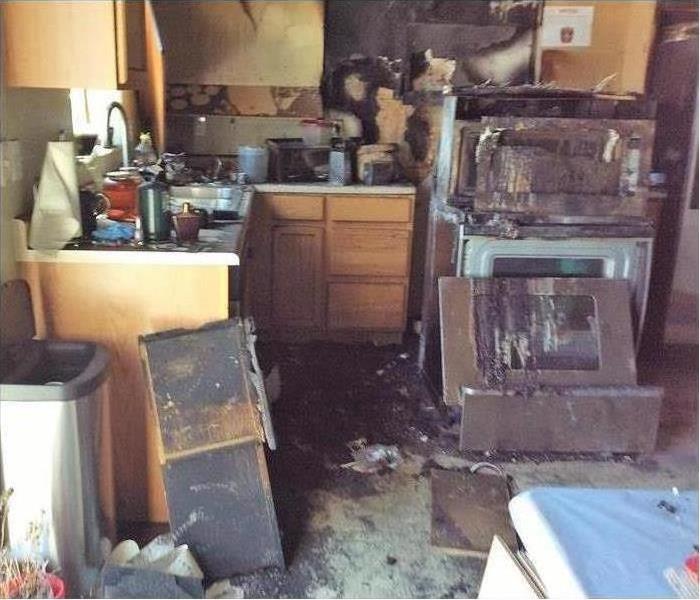 Kitchen fire due to faulty wiring on the wall in Colorado Springs, CO.
Kitchen fire due to faulty wiring on the wall in Colorado Springs, CO.
Have you ever wondered if one type of incident or action is more likely to lead to a home fire than another? As it turns out, there are five fire causes that are more prevalent than others. Read on to learn what they are and what you can do to avoid them.
- Cooking
Cooking fires are the number-one cause of all fires in the United States. They usually occur when someone leaves a kitchen appliance unattended while cooking. Frying creates the greatest threat.
- Heating Appliances
Devices such as furnaces and space heaters also pose a great fire risk. Much like with cooking fires, many of these accidents happen when a piece of equipment is left unattended or if it is operated incorrectly.
- Electrical Gear
A home fire can also be caused by equipment used for electrical or lighting purposes. This includes lamps, power outlets, and other objects that run on electricity. Once again, careful and attentive operation of electrical devices is crucial to stay safe.
- Intentional Situations
Unfortunately, many fires are started intentionally by those wishing to create chaos and destruction. Arson makes up the fourth-largest category of household fires in the United States. Many perpetrators are under the age of eighteen.
- Smoking-Related Accidents
Smoke-related fires are the fifth most common kind in the United States. Always practice common-sense safety procedures if you are planning on smoking in or near your Colorado Springs, CO, home.
A home fire is never pleasant to think about, but knowing the leading causes of these disasters can help you to avoid some of them and the aftermath of a fire, which can include fire cleaning. Remember to always call for help and evacuate the premises if a fire begins at home. Being educated is one of the first steps to take in order to keep your house, your family, and yourself safer each day.
What To Expect After a Commercial Roof Fire
9/14/2022 (Permalink)
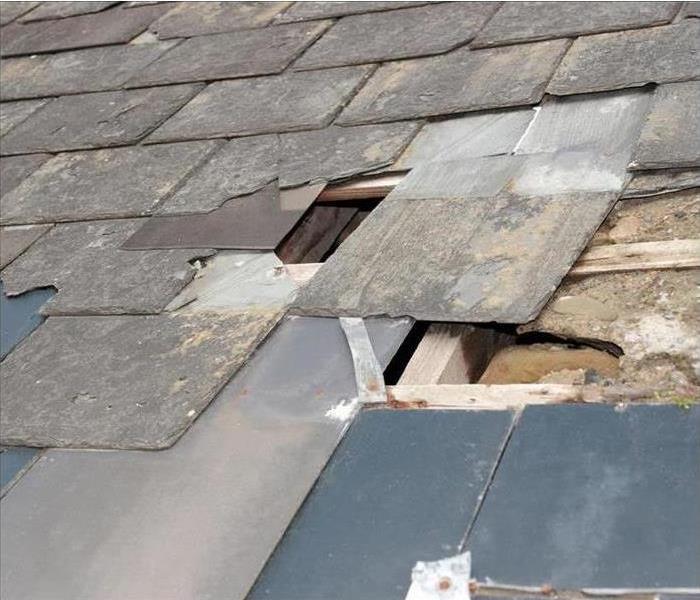 Roof damage after commercial fire.
Roof damage after commercial fire.
Roof damage can be tricky to recognize immediately after a fire, especially if your attention has been drawn toward the damage inside your commercial property and the people who were on your property during the fire.
3 Steps Professionals Take Right Away
However, when fire cleanup and repair professionals show up to assess your property, there are some steps they'll take right away:
- Secure your property
- Tarp over any holes on the roof
- Provide their initial assessment
It's best to assume that you'll need roof repair. If the heat and flames of the fire didn't directly damage the roofing materials, firefighters may have broken holes in the roof as part of their efforts to save the rest of the building.
Why Does Tarping Matter?
Some of the most important tasks involved in fire cleanup are included in tarp services. When technicians cover the holes in the roof, they protect the inside of your property from rain or snow, windblown debris, animals and insects. This work may also involve preventing others from entering your building without permission. This is a good way to avoid vandalism and other secondary damages.
What Should You Do After the Fire?
There are several other dos and don'ts you should also understand when your building has been damaged by fire:
- Do contact your insurance company as soon as possible. Provide these professionals with your insurance policy and account information.
- Do keep records of all conversations, receipts, and documents related to the fire, the resulting damage, and your insurance claim.
- Don't try to complete roof repair on your own. There are many safety hazards, and you could cause further damage, as well as making it more difficult for the insurance adjuster to establish the amount of damage.
- Don't enter the building until the fire department has completed all necessary safety inspections.
If your Colorado Springs, CO, property has been damaged by a fire, you'll need to rely on experienced fire cleanup professionals to help you get your building back into its pre-fire condition. Make sure you're prepared before a fire breaks out, so you can react confidently during an emergency.
What to Do After a Fire
7/18/2022 (Permalink)
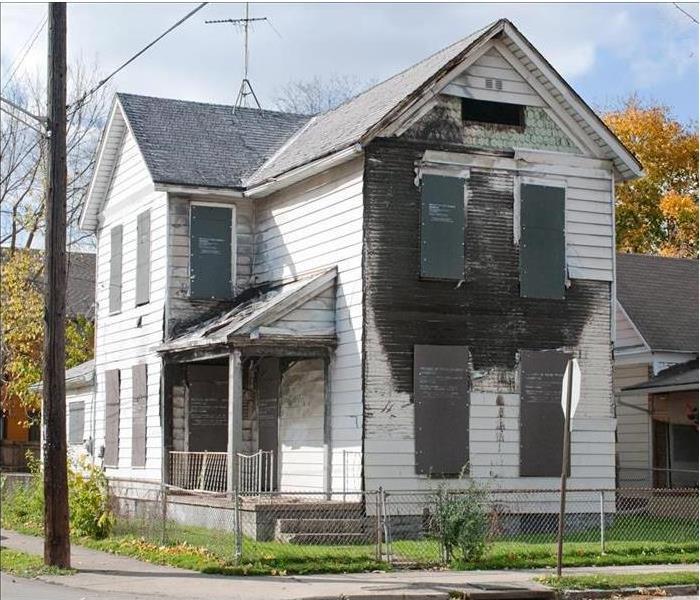 Board up after suffering fire damage.
Board up after suffering fire damage.
Immediately after a fire is a very stressful time. With all of the fire damage and loss, it can be difficult to see what to do next. The first thought on most people's minds is to repair the damage, but there are a few things that you should consider doing even before that. The very first thing you should do is call your insurance company. The second is to secure your home.
3 Steps to Follow After a Fire
Securing your home does not mean locking your doors. Remember that there could be hundreds of access points after a fire. Between the flames, smoke and the fire department, the damage can be extensive. When you secure your home, you will need to board up holes, windows and doors.
Here's why you need to tarp or board your home:
- Vacant homes are catnip to vandals and thieves
- Your insurance may require it
- Rain, wind and sun can make the damage worse
- Someone could go in and hurt themselves
You must cover all the exposed areas of your home as soon as possible.
When you are allowed back in your home, you will need to take an inventory. Take a look at what you need to throw out and what can be salvaged. Make sure you board up or tarp anything exposed to the elements while you are doing this. It is far easier to assess the damage and cover things that need to be covered simultaneously.
- Find a Restoration Company
You should also find a restoration company in Colorado Springs, CO, as soon as you talk to your insurance company. Some companies will even offer emergency board up services if they have to wait to start the repairs and remediation. Some of the reasons they may have to wait are delays with insurance or fire inspectors. This service will reduce the cost of your repairs and help to keep your home safe.
Fires are devastating. Just remember to board up, take inventory and find a remediation company that can help you. These steps can help you avoid any additional damage.
Reasons Your Smoke Alarm Is Beeping
6/23/2022 (Permalink)
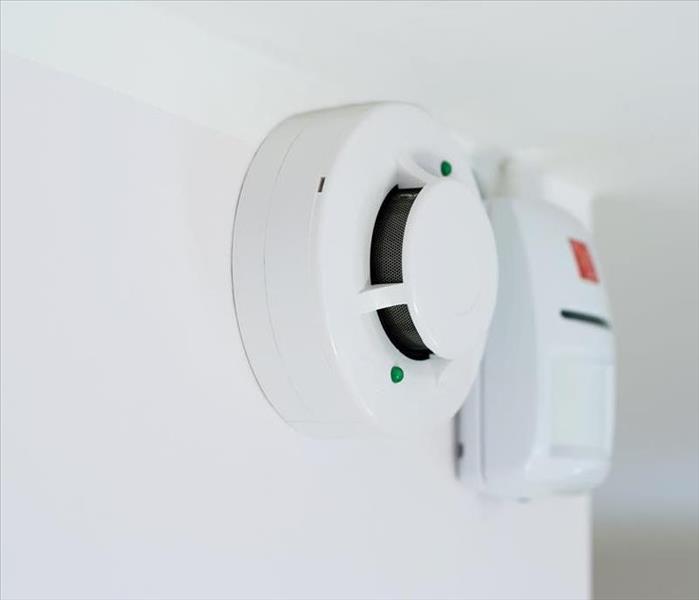 If Your Smoke Alarm Is Beeping, just Follow our Tips.
If Your Smoke Alarm Is Beeping, just Follow our Tips.
Ensuring your Colorado Springs, CO, home is outfitted with a fire alarm in various locations is essential for everyone’s safety. It is recommended to have one on every floor of the home and outside of sleeping areas. While they are an essential first alert to a problem, they may easily be forgotten until they start to show signs of trouble.
The Different Fire Alarm Beeps
If the smoke detectors in your home aren’t hardwired, it means they are running on a battery. Most standard alarms use a 9-volt battery, which should be replaced every six months. As the battery dies, it will lead to different sounds that are sure signs it’s time to inspect them.
1. Fast, Loud Beeping
Since these detectors are designed to detect the smallest bit of smoke, any loud and fast beeping means smoke has been detected. If there is no fire, it may be caused by tobacco smoke or cooking too close to the detector. It is recommended to install alarms at least 10 feet from cooking appliances.
2. Consistent Chirps in Intervals
If you hear approximately three chirps every 30 seconds, it is a sign that something is malfunctioning. If the fire alarm is more than eight years old, it likely needs to be replaced. In other cases, it may be a battery issue. Pressing the test button for a few seconds should help you determine if the battery needs to be replaced. Once pressed, it should produce a loud sound. If there is no sound, remove and replace the battery and test again.
3. Erratic Beeping
Irregular beeping often indicates that the battery is dying. If you know that it hasn’t been six months since it was replaced, the solution may be as simple as cleaning any dust or residue out of the battery compartment. Along with signaling a low battery, it may be an indicator that the battery isn’t properly positioned. Humidity may also be affecting the detector. Ensure that they are installed away from HVAC registers, open windows and ceiling fans.
If the problem persists, the residual charge may need to be cleaned. This requires holding the test button for approximately 30 seconds to reset the alarm. Pressing it again should result in normal beeping. If not, a replacement alarm may be needed.
4. Five Loud Chirps
Once you hear a loud chirp once every five minutes, it means the device is at the end of its life. End of device life. That is a clear indicator that it’s time to get a new alarm. When researching a replacement, it may be worth considering alarms with lithium-ion batteries. These alarms are designed to last 10 years without a battery replacement. After 10 years, you simply replace the unit.
Any beeping your fire alarm does that isn't related to smoke damage or flames should never be ignored. As the first line of defense against a fire, you don't want to take any risks. If a fire does occur, you can count on a fire damage restoration company to get your property back to what it was before.
How To Prevent a Lint Fire in Your Dryer
3/14/2022 (Permalink)
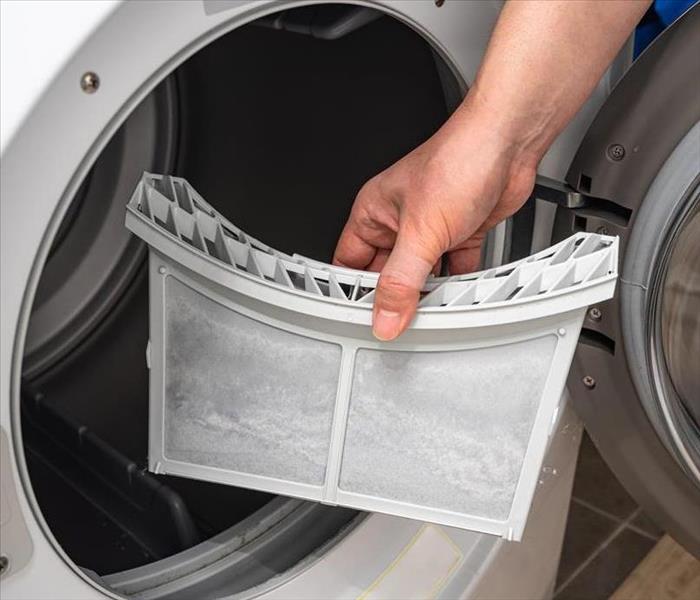 Avoid Fire Damage and Prevent a Lint Fire in Your Dryer by Following These Tips.
Avoid Fire Damage and Prevent a Lint Fire in Your Dryer by Following These Tips.
Lint in your dryer is not just a mere annoyance. It could also cause a lint fire that destroys your Colorado Springs, CO, house. That is why you should frequently clean the lint from your dryer. Removing the lint from the dryer screen is not enough. You also should do deep cleans of the vents and the interior. To keep your dryer functioning well and free of lint, all you need is:
- All-Purpose cleaner
- Vacuum
- Water
- Microfiber cloth
Prevent Dryer Fire by Eliminating Lint After Each Load
Whenever you finish running a dryer cycle, you should check the lint screen. Depending on the model you have, the screen could be on the side of the dryer, on the bottom of the door or at the top of appliance. You should be able to completely remove the screen by pulling it from the handle. Be careful not to pull too hard. If you bend the screen, you may not be able to get it back into the dryer.
After the screen is out of the dryer, use your hands or a brush to gather a small wad of lint. Rub this wad across the screen to attract additional lint. Then simply throw the lint into the garbage.
You may also want to rinse the lint screen with water every few weeks. Simply run the screen under the kitchen sink. You could additionally utilize soap if there is excess dust on the screen.
Before you put the screen back into the dryer, use your vacuum attachment to clean any lint that has accumulated in the vent. This should further keep your home safe from lint fire.
Deep Clean the Vents and Interior for Extra Fire Safety
Since a dryer fire can start in the interior sections of the appliance, you should deep-clean these areas twice a year, as well. Unplug the machine and move it away from the wall. You should notice an exhaust hose. You can remove it by loosening the clamps with a screwdriver.
Next, take the hose to a well-lit area. Use a vacuum attachment or cleaning brush to remove any lint balls you see. You can then utilize a cleaning rod to eliminate lint from the vent in the wall.
After re-attaching the exhaust hose, you should also brush or vacuum the dryer vent on the outside of your home. Be sure to put the vent securely back in place. Otherwise, rodents or other pests could enter your home.
The entire interior of your dryer should be deep-cleaned biannually, as well. Start by removing the back access panel. Wipe or vacuum any exposed sections, including the area around the exhaust vent. Just be careful when touching any of the wires near the vent. If you opt to clean the metal parts of the dryer, use a microfiber cloth. Once you are done, screw the panel back into place.
The above tips should keep your dryer functioning properly and reduce your chances of a lint fire. If your dryer or another appliance ever does cause fire damage to your home, emergency restoration professionals can assist you.
Understanding the Common Causes of a Home Fire
2/23/2022 (Permalink)
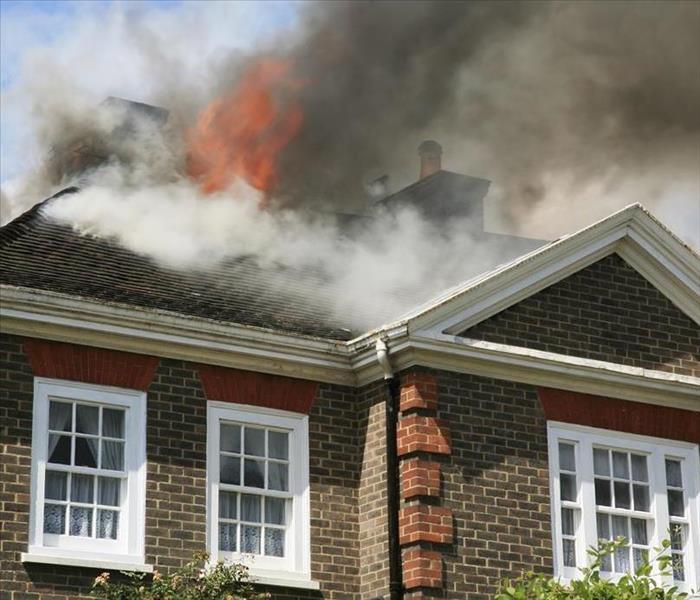 Follow These Tips about Common Causes of a Home Fire and avoid Fire in your Colorado Springs, CO house.
Follow These Tips about Common Causes of a Home Fire and avoid Fire in your Colorado Springs, CO house.
A home fire is a nightmare for many homeowners. While most people feel like they are safe from such events, the statistics show that house fires occur more often than people might like to think. While fire restoration services in Colorado Springs, CO, acknowledge a drop in fires and fire-related deaths since the 1970s, the danger is still prevalent.
According to the National Fire Protection Association, a fire department in the U.S. responds to a fire somewhere in the country every 23 seconds. The causes of home fires are usually not odd or extraordinary things. Most causes of house fires include:
- Candles
- Grills
- Faulty appliances
4 Common Causes of a Home Fire
When reviewing fire causes, it is necessary to check the habits and tools that can lead to such disasters. People often do not realize how lax behaviors or failed maintenance can result in many household fires.
1. Home Cooking
Many house fires start in the kitchen. It is common for stovetop meals to include the use of grease or other flammable elements. Unfortunately, while cooking fires are common, they can quickly become uncontrollable, especially with bad habits.
Too many people leave the kitchen or get distracted while cooking. Leaving the room is one of the worst things you can do. Grease fires can quickly get out of hand and spread to other surfaces. However, if you are present in the room, a grease fire can be extinguished rather quicker by snuffing the flames, using a fire extinguisher, or throwing baking soda onto the flames.
2. Matches, Candles, Lighters
When fire cleaning, many restoration companies find that the cause of the fire was a candle. People love to use candles, but they can become lax around the decorations, leaving them lit in the presence of children or pets.
Again, it is not uncommon for people to leave a room where a candle remains lit. Anytime an open flame is left unattended, it becomes a fire hazard. If you have lighters and matches in your home, make sure they are out of reach of children. Many house fires are caused by accidents when children decide to play with matches.
3. Faulty Electronics
Faulty electronics and wiring are other leading causes of house fires. Many times, these faults occur because of failed maintenance or improper use. You should always follow maintenance guides and recommendations for appliances and other electronics. Additionally, it would be best to have regular inspections of your home's electrical system.
4. Smoking
Smoking is an unhealthy habit and potentially dangerous. Cigarettes cause about 5% of residential structure fires. Additionally, nearly 25% of fire-related deaths were a result of smoking.
The careless disposal of cigarettes or smoking on upholstered furniture are common causes of cigarette-related fires. The cause of the fires is often a result of falling embers.
No property owner wants to experience a home fire; they are dangerous and destructive. The best way to avoid a fire is by adopting basic fire safety practices and being aware of the common fire causes above. Contact your local fire department or fire restoration service for more information about protecting your home.
Prevent a Dryer Fire With Cleaning Tips
1/5/2022 (Permalink)
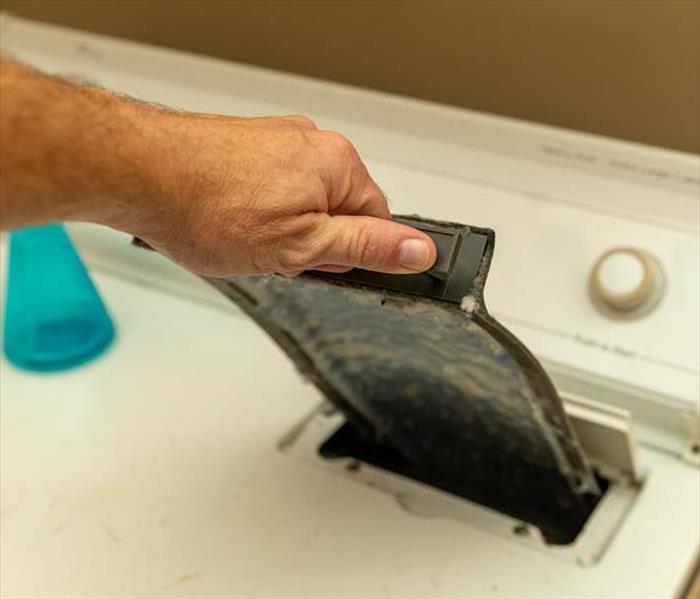 Consider these Cleaning Tips to prevent a Dryer Fire in your Colorado Springs, CO house.
Consider these Cleaning Tips to prevent a Dryer Fire in your Colorado Springs, CO house.
While dryers are some of the most pleasant appliances in the home, they are also, sadly, one of the most dangerous when it comes to home fires. According to the U.S. Fire Administration, nearly 3,000 fires are caused by dryers each year. The most common of those fires is the lint fire.
You can tell if you have too much lint built up in your appliance:
- It takes longer to get clothes dry.
- Clothes are moist after a cycle.
- The appliance feels hot when you touch it.
- You can smell the heat from your appliance.
- There's a lot of humidity in your laundry room.
- There's very little air coming from the exhaust vent.
You should empty the lint trap every time you run a cycle through the dryer, but even with this step, there may still be lint trapped throughout the dryer and through the vent. Cleaning Tips To Prevent a Lint Fire With a little bit of prevention, you can improve the efficiency of your dryer and reduce the risk of a dryer fire in your Colorado Springs, CO home.
Bear in mind these Cleaning Tips to prevent a Dryer Fire
Clean the Lint Screen
The screen in your dryer may be at the top of the machine, on the side, or at the bottom front inside the door. Pull this out every time you run a cycle and remove the lint from the screen. If the screen needs more attention, you can run it under the faucet in your sink and rinse thoroughly until it is free of dust and residue from dryer sheets.
Vacuum the Screen Vent
This step doesn't need to be repeated with every cycle but should be completed after most loads. Use the attachment on your vacuum to remove lint you can't reach by hand. Vacuuming the lint from the vent prevents clogs and keeps lint out of the other compartments of the dryer.
Deep Clean the Machine
If you have an older dryer or if your appliances are attached to gas lines, contact an appliance professional to perform deep cleans. Unplug the dryer and pull it away from the wall. Look for the access panel at the back or side of the appliance. Once it is open, use a vacuum and soft rag to remove any lint, debris, and the occasional sock. Be gentle around the heating element and wiring. With everything cleaned up, reattach the access panel. An appliance, vent, and exhaust hose deep clean should be done every six months at least. Do this more often if you run a lot of loads of laundry.
Clean the Vents and Exhaust Hose
The machine should be unplugged and pulled out for this task. Carefully find the exhaust hose and loosen the O-ring clamp that keeps the hose in place. Watch for clamps at both ends of the hose and have a screwdriver handy to remove any bolts. Once the hose is unclamped, use a vacuum or long brush to remove lint and debris. Use a cleaning rod to reach into the wall; these are available at hardware stores. Follow the directions on the package for the best results.
Cleaning the lint from your dryer regularly is a great way to avoid a lint fire. If your home has suffered from fire damage, contact fire and smoke cleanup professionals for repairs and restoration.
6 Steps To Take After a House Fire
8/20/2021 (Permalink)
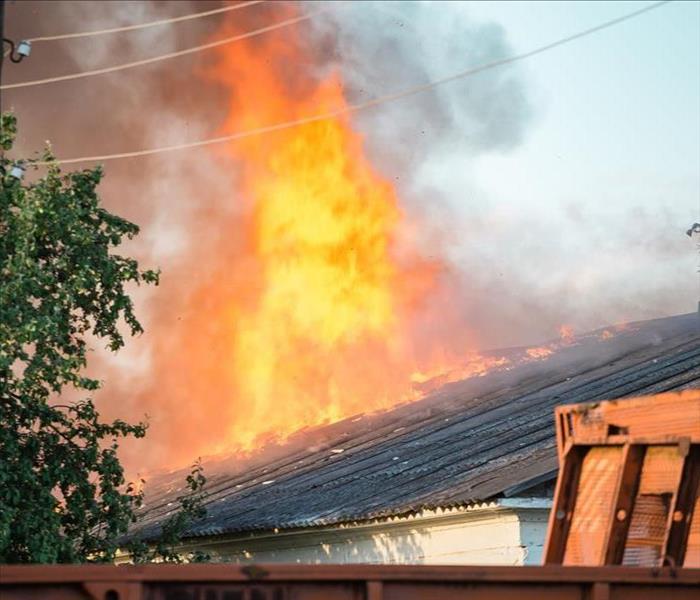 Hire a professional team to help with your fire-damaged house in Colorado Springs, CO.
Hire a professional team to help with your fire-damaged house in Colorado Springs, CO.
In the aftermath of a house fire, it's challenging to know which way to turn next. The fire has just ravaged your Colorado Springs, CO, home, so now it's time to begin rebuilding your life as quickly and efficiently as possible, from the fire restoration process to recovering your possessions.
Here are six steps to take after a house fire.
1. Protect Your Family and Pets
Immediately when everyone is safe from the fire, make sure your pets are unharmed. They'll probably be scared and may not act normally. Just remember, they don't understand what's going on. Give them love and care and reassurance, and keep them in a safe, calming area.
2. Contact Your Insurance Company
Home fire insurance policies typically require policyholders to file claims as soon as they can safely do so. First, call your insurance adjuster to report the loss and begin the claim process. Next, the insurance company will require you to list everything you lost in the fire and each item's value. You'll submit this information in a proof of loss claim.
3. Inventory Your Losses
While you're inventorying your losses, make sure you don't throw anything away. The insurance adjuster may want to see it and photograph it as proof of loss before fire restoration begins. You can also be proactive and list your property and its value in case such a disaster occurs. Take pictures of different rooms of your home showing the contents. Doing it beforehand will ease some stress after a disaster.
4. Reach Out for Help
Contact a local disaster relief agency, such as the American Red Cross, if you need temporary housing or other essentials, such as food and clothes. Most homeowners' policies will also provide a certain amount of money for living expenses if you can't occupy your home. Friends, family, and local churches are often happy to help with whatever is needed, such as donating household items or childcare.
5. Secure Your Home
The insurance company requires policyholders to take reasonable actions to protect their property after a loss to protect it from further damage. Mitigating damage after a fire could include tarping the roof, boarding up windows, or installing a temporary security fence. It could also mean moving undamaged items to unaffected areas to keep them out of harm's way. The insurance company probably won't pay for secondary damage that could've been avoided, so it's essential to do as much as possible to minimize the damage.
6. Schedule Professional Restoration
Professional restoration must be performed on a fire-damaged house. Fire damage restoration professionals have years of expertise and industrial-grade equipment for making sure the job is performed properly and as quickly as possible to prevent more damage. From soot and smoke cleaning to odor removal, water extraction, and mold mitigation, they'll return your home to code as soon as possible. They'll also do a thorough inspection to ensure all problems have been addressed.
Fire restoration must begin as quickly as possible after a house fire to mitigate any additional damage and return your life to normal. Proactively familiarizing yourself and your family with the process before a disaster occurs can prove to be advantageous should the worst happen.
Fire prevention tips for El Paso and Elbert county
8/17/2021 (Permalink)
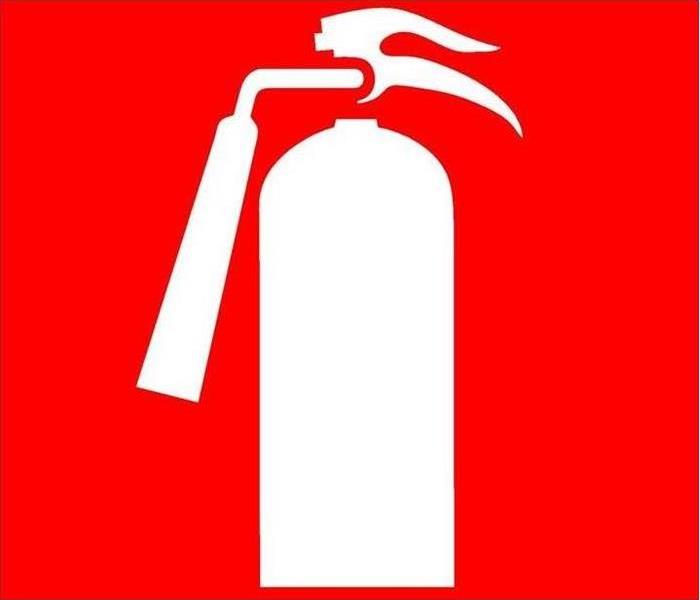 Preventing fire with small steps can go a long way.
Preventing fire with small steps can go a long way.
According to the National Fire Protection Association in 2015, there were 500,000+ structure fires causing $10+ billion in property damage! Structure fires were reported every 63 seconds!
Here are a few tips to prevent a fire at your Colorado Springs, CO, home or property, provided by the American Red Cross.
- Keep items that can catch on fire at least three feet away from anything that gets hot, such as space heaters.
- Talk to children regularly about the dangers of fire, matches, and lighters and keep them out of reach.
- Turn portable heaters off when you leave the room or go to sleep.
- Install smoke alarms on every level of your home and outside every sleeping area. Also, install a carbon monoxide alarm in a central location outside each separate sleeping area.
- Check electrical wiring in your home.
- Avoid overloading outlets or extension cords.
- Make sure wiring is not under rugs, attached by nails, or in high traffic areas.
Have you checked your home or property for fire hazards recently? Have you had conversations with your family about what you would do in a fire emergency? What is your plan if a fire impacts your home?
SERVPRO of North Central Colorado Springs specializes in the cleanup of residential and commercial property after a fire or smoke damage event and can help you get back on track after an incident.
SERVPRO of North Central Colorado Springs is locally owned and operated—so we’re a part of this community too. We are also part of a national network of over 1,700 Franchises, which enables us to respond quicker with more resources. For major storms and disasters, we can call upon special Disaster Recovery Teams strategically located throughout the country.
SERVPRO of North Central Colorado Springs proudly serves Colorado Springs, Fountain, Security-Widefield, Black Forest, Peyton, Calhan, Woodland Park, Ellicott, and all of Elbert and El Paso County. Call us with your mitigation concerns at (719) 266-0881
Leading Causes of Home Fires
5/25/2021 (Permalink)
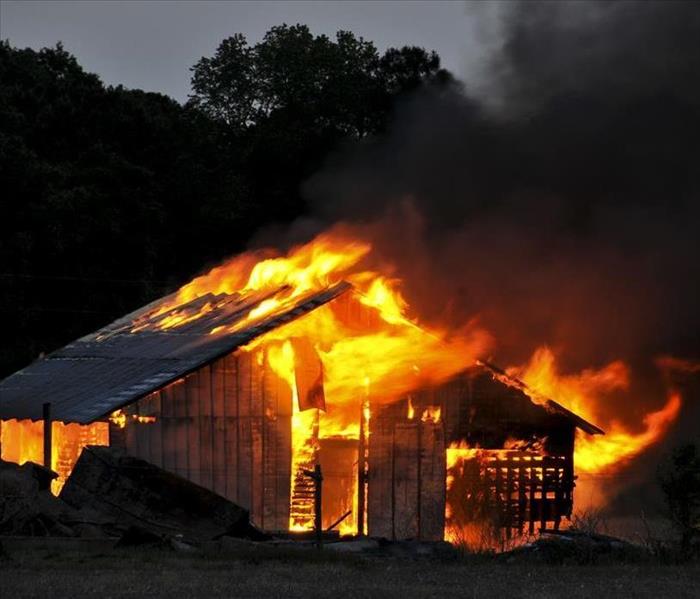 Prevent home fires.
Prevent home fires.
A fire can be devastating to the people involved. This is why it is important to know and understand the most common causes of a home fire. Knowing the causes can help stop it from happening to you.
Kitchen and Cooking Fires
Accidents in the kitchen cause the majority of household fires in the United States. Some things that happen are:
- Flammable items are left near flame, heat or burners
- Frying with oil
- Setting cooking temperatures too high
- Cooking while tired or otherwise impaired
Fortunately, most of the kitchen fire causes are preventable with a bit of caution.
Home Heating and Cooling Fires
Home heating and cooling is the second most common cause of a household fire. In this case, it is not always preventable. It is a good idea to have your heating and cooling system inspected at least once per year to help offset the danger.
Intentional Fires
The third leading cause of a home fire is intentional. When most people think of intentional fires, they immediately think of arsonists. This is not always the case. For insurance and remediation companies in Colorado Springs, CO, this can mean using a heat source such as a space heater or stove for something that was not intended, such as using a microwave to dry clothing.
Cigarette Fires
Surprisingly cigarette fires, rate fairly high on this list. These are fires caused by cigarettes or other smoking tools and are usually relatively localized so they don't require a lot of fire cleaning. A bit of preventative care will help you avoid this type of fire.
Washing Machines and Dryer Fires
Washing machines and dryers cause a lot of problems. When it comes to washing machines, the combination of faulty wiring and water can start a fire. In the case of dryers, the leading cause of the fire is the combination of lint and heat. Dryer lint is extremely flammable.
In most cases, the home fire is preventable. Knowing the leading causes helps. Make sure that you are doing everything you can to make sure it doesn't happen to you.
Does Renters Insurance Cover Fire?
2/23/2021 (Permalink)
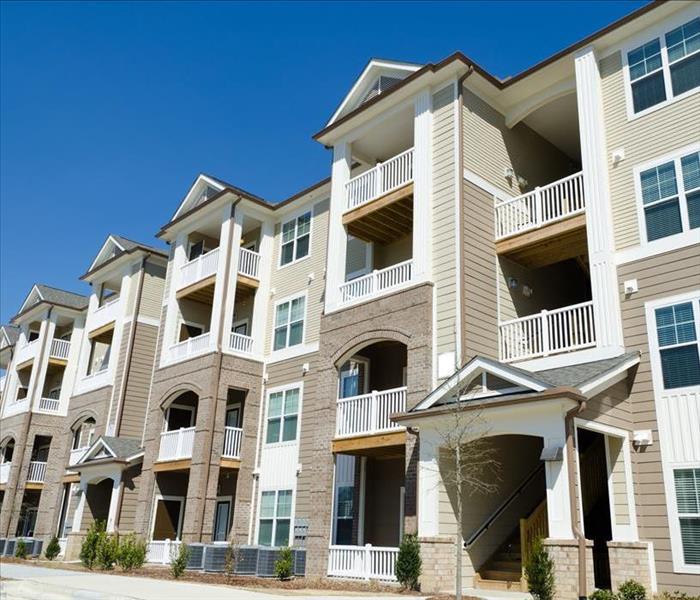 Renters insurance provides different coverages for various types of fire damage.
Renters insurance provides different coverages for various types of fire damage.
Because the property owner's insurance does not cover the personal property of tenants, it is important for renters to purchase their own coverage. The short answer to the question of whether renters insurance covers fire is that it does. However, different types of coverage apply to fire damage in different ways.
Different Types of Renter Insurance Coverage for Fire Damage
Personal Property
The primary reason for renters to purchase fire coverage is to replace personal property damaged or destroyed in a fire. Examples of personal property include:
- Clothing
- Electronics
- Furniture
- Home decor
- Cash
Some types of property may be specifically excluded or have different limits, such as jewelry, cash, guns and musical instruments. Most policies cover personal property at replacement value, but some may cover it at actual cash value, which is the replacement value less depreciation. If you need a fire restoration service in Colorado Springs, CO, to clean your smoke damaged property, this may be covered by your policy.
Liability
Another coverage provided by most renters insurance policies is liability. This means that if you accidentally cause a fire in your rental unit, your liability coverage may pay for any damages to the building or injuries to other tenants or guests that you are legally liable for.
Medical Payments to Others
Most renters policies provide a small amount of coverage for medical payments to others. This is no-fault coverage, so it applies, even if you didn't cause the fire. This coverage might apply if you had a guest in your apartment and that person needed medical attention due to smoke inhalation from a fire in your kitchen.
Loss of Use
If a fire makes your apartment uninhabitable, loss of use coverage may apply. This coverage may reimburse you for additional living expenses, such as paying for a hotel room.
Renters insurance provides a variety of coverages for various types of fire damage. If you are unsure what your policy covers, your insurance professional can review your policy with you and make adjustments as needed.



 24/7 Emergency Service
24/7 Emergency Service













